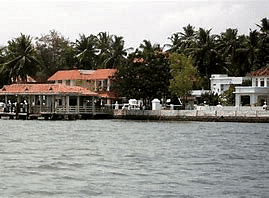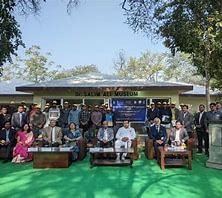UPSC Daily Current Affairs- 22nd January 2024 | Current Affairs & Hindu Analysis: Daily, Weekly & Monthly PDF Download
GS-I
Willingdon Island
Subject: Geography

Why in News?
Recently, the Cochin Port Joint Trade Union Forum has urged the Prime Minister of India to take effective steps to revive the lost glory of Willingdon Island.
About Willingdon Island:
- It is among the most beautiful locations in the Kochi area.
- This is a man-made island, named after Lord Willingdon who was a British Viceroy of India.
- It is among the biggest of its kind in India.
- It is a major commercial centre and has some of the best hotels in the city.
- It is also home to the Kochi Naval Base of the Indian Navy, the Central Institute of Fisheries Technology and the Port of Kochi.
- It handles millions of tonnes of freight every year.
- The island is connected to the mainland by the Venduruthy Bridge.
Who was Lord Willingdon (1931 - 1936)?
- He was the 22nd Viceroy and Governor-General of India.
- Major events during his tenure
- Introduction of the Government of India Act, 1935.
- The Second Round Table Conference, held in 1931, saw the participation of Gandhi as a representative of the Congress.
- British Prime Minister Ramsay MacDonald introduced the Communal Award in 1932.
- The Poona Pact of 1932was reached between Gandhi and Ambedkar to address provisions related to fair representation of backward classes.
- The Third Round Table Conference, held in 1932, failed as neither Gandhi nor Congress attended.
Source: Hindu Business Line
Madhika: A Perishing Language with just 2 Speakers
Subject: Art and Culture

Why in News?
In the remote colony of Kookanam, Kerala, the Chakaliya community faces a sobering reality—their unique language, Madhika, teeters on the brink of extinction.
- With no script to preserve it, Madhika is struggling for survival, and the last two speakers.
About Madhika Language
- A Linguistic Blend: Madhika may sound reminiscent of Kannada, but its influences run deeper, encompassing Telugu, Tulu, Kannada, and Malayalam.
- Endangered Heritage: The younger generation, drawn to mainstream languages like Malayalam, shows little interest in preserving Madhika, leading to its decline.
Chakaliya Community’s History
- Nomadic Origins: The Chakaliya community was once nomadic and worshippers of Thiruvenkatramana and Mariamma.
- Migration to Kerala: Centuries ago, they migrated from the hilly regions of Karnataka to northern Malabar in Kerala.
- Change in Status: Initially recognized as Scheduled Tribe, they were later included in the Scheduled Caste category in Kerala.
- Historical References: References to the Chakaliya community can be found in the book “Caste and Tribes of Southern India.”
Social Stigma and Its Impact
- Untouchability and Dehumanization: The Chakaliya community faced social stigma, including untouchability and exclusion from important feasts and ceremonies.
- Modern Disassociation: Many young and educated members of the community seek to disassociate themselves from the past, preferring to speak Malayalam over Madhika.
Source: The Hindu
How Ramayana became popular outside India?
Subject: Art and Culture

Why in News?
The epic narrative of the Ramayana, cherished in India for millennia, has transcended its geographical boundaries to become a cherished tale worldwide.
- This enduring journey of the Ramayana highlights how the Indian diaspora, including traders, preachers, and indentured laborers, played a pivotal role in its global dissemination.
Ramayana’s Path across Asia
- The Ramayana embarked on its Asian voyage during the early centuries of the Common Era. It traversed three distinct routes:
- Northern Route: From the regions of Punjab and Kashmir, the epic story ventured into China, Tibet, and East Turkestan overland.
- Southern Route: Originating from Gujarat and South India, it sailed across seas to reach Java, Sumatra, and Malaya, making it a significant part of these cultures.
- Eastern Route: Through the eastern overland route, the Ramayana entered Burma, Thailand, and Laos, reaching Vietnam and Cambodia via Java.
- This expansion was primarily attributed to Indian traders who embarked on their journeys for commerce, trading spices, gold, and aromatic wood.
- Many of these travelers eventually settled in these regions, contributing to the dissemination of Indian religion, culture, and philosophy.
Cultural Influence on Southeast Asia
- The Indian diaspora brought with them a profound influence on the native cultures of Southeast Asia.
- Brahmin priests, Buddhist monks, scholars, and adventurers played a crucial role in transmitting Indian traditions.
- Over time, the Ramayana became an integral part of these countries’ cultural fabric.
- Thailand: The Ayutthaya kingdom drew inspiration from the Ramayana, with Ayutthaya itself resembling the mythical city of Ayodhya. The Ramayana remains Thailand’s national epic, profoundly influencing its culture and royalty.
- Cambodia: The Angkor Wat temple complex, originally dedicated to Vishnu, features captivating murals narrating episodes from the Ramayana.
Contemporary Influence in Southeast Asia
- Even today, the Ramayana continues to hold a significant place in the cultures of Southeast Asian countries.
- Despite diverse dominant religions, ranging from Buddhism to Islam, the epic persists as a source of inspiration.
- Thailand: The Ramakien, a Thai version of the Ramayana, is Thailand’s national epic, with rulers of the Chakri dynasty adopting names from the Ramayana.
- Laos: The story of Phra Ram is considered the national epic, with unique interpretations reflecting Lao culture.
- Variations in these narratives often mirror local cultures and traditions, emphasizing the enduring appeal of the Ramayana across Southeast Asia.
Ramayana beyond Asia
- The 19th century witnessed another phase in the global dissemination of the Ramayana, propelled by the movement of indentured laborers, known as girmitiyas, from India to regions such as Fiji, Mauritius, Trinidad and Tobago, Guyana, and Suriname.
- These laborers carried with them the cultural heritage of India, prominently featuring Tulsidas’s Ramcharitmanas, an iconic religious text in North India.
Preservation amidst Adversity
- Girmitiya Migration: Indentured laborers, primarily from Uttar Pradesh and Bihar, were sent abroad to work on plantations after the abolition of slavery.
- Preservation of Culture: Despite their modest means, the girmitiyas preserved their culture and religion. The Ramcharitmanas became a symbol of their homeland in an unfamiliar land.
- Cultural Sustenance: The Ramayana offered solace and nostalgia, fostering a sense of belonging and connection to their roots.
Conclusion
- Remarkable journey of the Ramayana from India’s heartland to distant shores underscores the enduring power of storytelling, culture, and tradition.
- Whether in the ancient temples of Southeast Asia or the hearts of indentured laborers in faraway lands, the Ramayana continues to inspire and resonate, bridging the geographical gaps of our diverse world.
Source: Indian Express
GS-II
Bureau of Police Research and Development
Subject: Polity and Governance

Why in News?
Recently, the Bureau of Police Research and Development (BPRD) has warned users of different scams perpetrated through messaging platform WhatsApp.
About Bureau of Police Research and Development:
- It was set up in 1970 under the Ministry of Home Affairs by replacing the Police Research and Advisory Council.
- Objectives
- To identify the needs and problems of the police in the country.
- To undertake research projects and studies, and suggest modalities to overcome problems and challenges and meet the needs and requirements of the police.
- It was also mandated to keep abreast of the latest developments in the fields of science and technology, both in India and abroad, with a view to promoting the use of appropriate technology in police work.
- It is also assisting the States in modernization of the State Police Forces and Correctional Administration.
- More recently, the BPR&D has also been entrusted with the responsibility of anchoring and coordinating the work of the National Police Mission.
Source: The Hindu
GS-III
Three-year deadline to free Chhattisgarh from Maoist menace
Subject: Defense and Security

Why in News?
At a review meeting of Chhattisgarh’s Left-Wing Extremism (LWE) situation held in Raipur, Union Home Minister emphasised the need to free the affected pockets of the State within the next three years.
- The minister highlighted that the problem was confined only to certain pockets of Chhattisgarh.
- In the past couple of months, the number of anti-Naxal operations have been on the rise in Bastar and other LWE-affected areas of the State.
Left Wing Extremism (LWE)
- Left-wing extremism is the single internal security threat that affects the largest number of States in India.
- LWE aims to overthrow the existing democratic state structure with violence as their primary weapon, and mass mobilization and strategic united fronts as complementary components.
- They plan to usher in So-called ‘New Democratic Revolution’ in India.
- Left-wing extremists are popularly known as Maoists worldwide and as Naxalites in India.
Reasons for the spread of LWE
- Land Related Factors:
- Encroachment and occupation of Government and Community lands (even the water-bodies) by powerful sections of society.
- Lack of title to public land cultivated by the landless poor.
- Poor implementation of laws prohibiting the transfer of tribal land to non-tribals in the Fifth Schedule areas.
- Non-regularisation of traditional land rights.
- Displacement and Forced Evictions:
- Eviction from lands traditionally used by tribals.
- Displacements caused by irrigation and power projects without adequate arrangements for rehabilitation.
- Large scale land acquisition for ‘public purposes’ without appropriate compensation or rehabilitation.
- Livelihood Related Causes:
- Lack of food security – corruption in the Public Distribution System
- Disruption of traditional occupations and lack of alternative work opportunities.
- Deprivation of traditional rights in common property resources.
- Social Exclusion:
- Denial of dignity.
- Continued practice, in some areas, of untouchability in various forms.
- Poor implementation of special laws on prevention of atrocities, protection of civil rights and the abolition of bonded labour etc.
- Governance Related Factors:
- Corruption and inadequate provision/non-provision of essential public services including primary health care and education.
- Misuse of powers by the police and violations of the norms of law.
- Perversion of electoral politics and unsatisfactory working of local government institutions.
Current LWE situation in India
- Maoist violence came down
- According to the Ministry of Home Affairs:
- Maoist violence in the country has gone down by 77% since 2010;
- The number of resultant deaths (security forces + civilians) has come down by 90 % from the all-time high of 1,005 in 2010 to 98 in 2022.
- According to the Ministry of Home Affairs:
- Number of districts declared to be Naxal-affected
- The government has cut the number of districts declared to be Naxal-affected from over 200 in the early 2000s to just 90 now.
- It claims that the geographical spread of violence is actually restricted to just 45 districts.
- According to the MHA, the arc of violence has been considerably restricted with just 25 districts accounting for 90% of the LWE violence.
- The presence of Naxals is said to be minimal to zero in Andhra Pradesh, Telangana, Odisha, Jharkhand, and Bihar, which were at one time their strongholds.
Why does Chhattisgarh continue to remain troubled?
- Late involvement of State Police in counter-Maoist operations
- It is a widely accepted principle in counter-Maoist strategy that the war against Left Wing Extremism can only be won by the state police and not central forces.
- This is because the state police have local knowledge and have local networks that are essential for the generation of intelligence.
- It was through the active involvement of local police in the leading role that states such as Andhra Pradesh, West Bengal, Odisha and Jharkhand were able to end their Maoist problem.
- This process, security establishment sources say, started late in Chhattisgarh.
- By this time, police of neighbouring states had pushed Maoists from their states to Chhattisgarh, making it a concentrated zone of Maoist influence.
- It is a widely accepted principle in counter-Maoist strategy that the war against Left Wing Extremism can only be won by the state police and not central forces.
- Absence of roads in the interiors of Bastar
- The absence of roads in the interiors of Bastar has stymied the operations of security forces.
- Minimal presence of the administration in the interiors of South Bastar has ensured that Maoists continue to have influence in the region.
Response by Centre
- Different schemes to support LWE states
- Security Related Expenditure (SRE) - focuses on equipping security forces to fight Maoists;
- The Special Infrastructure Scheme (SIS) - aims to strengthen local police and intelligence set ups;
- Special Central Assistance for building infrastructure such as roads in LWE districts.
- Massive presence of the CRPF
- The Centre has maintained a massive presence of the CRPF in the affected states for almost two decades.
- Erection of mobile towers
- Centre is pushing for the erection of mobile towers in the interiors, which would help the local people connect with the mainstream, and also generate technical intelligence.
- Maoists sympathisers on the radar of Centre
- The Centre has also unleashed the counter-terrorism National Investigation Agency (NIA) and the Enforcement Directorate on CPI(Maoist) cadres, leaders, and sympathisers with the aim to choke their funding.
Source: Indian Express
Skink
Subject: Environment and Ecology

Why in News?
Recently, a team from the Thackeray Wildlife Foundation (TWF) has discovered the first-ever viviparous skink genus and five new species belonging to it from peninsular India.
About Skink:
- Skink is the common name for the lizards that comprise the family Scincidae.
- It is typically smooth and shiny with small or rudimentary legs.
- It is a type of reptile that has been around since the time of the dinosaurs.
- They are mostly secretive ground dwellers or burrowers.
- Skinks are highly alert, agile and fast moving and actively forage for a variety of insects and small invertebrates.
- Habitat: They can be found in a variety of habitats, from deserts to rainforests, and are well-known for their ability to camouflage with their surroundings.
- Distribution: These are represented throughout most of the world but are especially diverse in Southeast Asia and its associated islands, the deserts of Australia, and the temperate regions of North America.
Source: Deccan Herald
Re-evaluating the Use of Mosquitofish in India
Subject: Environment and Ecology

Why in News?
In recent months, several regions in India, including Andhra Pradesh, Odisha, and Punjab, have resorted to releasing mosquitofish into local water bodies as a means to combat mosquito-borne diseases.
- While this approach aims to address a pressing public health concern, it brings to light ecological challenges associated with the introduction of mosquitofish.
Understanding Mosquitofish
- Biological Control of Mosquitoes: Mosquitofish, particularly Gambusia affinis and Gambusia holbrooki, were introduced in freshwater ecosystems in the 1960s as an eco-friendly alternative to chemical pesticides for mosquito control.
- Widespread Distribution: Originally native to the U.S., these fish have become global inhabitants due to their adaptability and tolerance to environmental fluctuations.
- Unintended Consequences: Despite good intentions, the proliferation of mosquitofish has led to detrimental ecological and environmental effects.
Historical Use in India
- Early Introduction: Gambusia was first introduced in India in 1928 during British rule as a measure to combat malaria.
- Government and Non-Governmental Involvement: Various governmental organizations, such as the Indian Council of Medical Research (ICMR) and the National Institute of Malaria Research (NIMR), as well as local municipal corporations and health departments, were entrusted with introducing mosquitofish.
- Widespread Distribution: Gambusia species are now established in multiple habitats across India.
Ecological Impact
- Invasive Alien Species: Mosquitofish are among the hundred most detrimental invasive alien species worldwide, leading to the displacement and extinction of native fauna.
- Threat to Biodiversity: They exhibit voracious feeding habits and aggressive behavior, posing a threat to native fish, amphibians, and freshwater communities.
- Global Examples: Studies in Australia, New Zealand, and India have shown the harmful consequences of Gambusia presence, including the decline of endemic species and predation on native fish and frogs.
Sustainable Alternatives
- WHO Recommendations: The World Health Organization stopped recommending Gambusia as a mosquito control agent in 1982.
- Government Recognition: In 2018, the National Biodiversity Authority of the Government of India designated G. affinis and G. holbrooki as invasive alien species.
- Local Solutions: Collaborative efforts between mosquito biologists, entomologists, invasion ecologists, and fish taxonomists can identify native fish species capable of mosquito control.
- River Basin Approach: Authorities can compile lists of native fish species in each river basin that are effective in controlling mosquito larvae, offering an eco-friendly alternative to invasive species.
Conclusion
- The introduction of mosquitofish in India, once intended to combat mosquito-borne diseases, has led to ecological challenges and the disruption of native ecosystems.
- To mitigate the adverse effects and protect indigenous aquatic biodiversity, it is essential to discontinue the use of Gambusia and instead explore sustainable alternatives rooted in local solutions.
- By adopting a river basin approach and collaborating across disciplines, India can strike a balance between mosquito control and environmental preservation.
Source: Health Economic Times
Amrit Dharohar Capacity Building Scheme 2023
Subject: Environment and Ecology

Why in News?
The Indian government has launched the ‘Amrit Dharohar Capacity Building Scheme’ 2023 to convert ecologically fragile wetlands, designated as Ramsar sites, into sustainable tourist attractions.
- This initiative seeks to create jobs and support local communities’ livelihoods in the process.
‘Amrit Dharohar Capacity Building Scheme’ 2023
- Launched in 2023-24 Budget: This scheme was introduced as part of the budget for 2023-24.
- Objective: It aims to promote the conservation values of Ramsar Sites while creating employment opportunities and supporting local livelihoods.
- Enhancing Livelihoods: The scheme seeks to enhance livelihoods for local communities by tapping into the nature-tourism potential of Ramsar Sites nationwide.
- Collaborative Effort: It is being implemented through collaboration with various Central Government ministries, State wetland authorities, and a network of formal and informal institutions and individuals working together for conservation.
About Ramsar Sites: International Significance
- Definition: Ramsar sites are wetlands designated as internationally important under an environmental treaty established in 1971 in Ramsar, Iran, under UNESCO’s auspices.
- Waterfowl Habitat: They are identified for their role as critical waterfowl habitats.
- Conservation and Sustainable Use: Ramsar encourages national and international efforts for wetland conservation and sustainable resource utilization.
- India’s Ramsar Sites: India boasts 75 Ramsar sites, showcasing its commitment to wetland conservation.
Pilot Projects and Skill Development
- Identified Sites: Among India’s Ramsar sites, 16 have been identified for the mission.
- Pilot Projects: Five wetlands, including Sultanpur National Park (Haryana), Bhitarkanika Mangroves (Odisha), Chilika Lake (Odisha), Sirpur (Madhya Pradesh), and Yashwant Sagar (Madhya Pradesh), have been selected for the initial pilot phase.
- Alternative Livelihood Programme (ALP): Participants receive training under ALP to explore alternative livelihood opportunities.
- Paryatan Navik Certificate: Additionally, a boatman certification program is offered to tourism service providers, ensuring a skilled workforce.
Ecological Significance of Wetlands
- “Earth’s Kidneys”: Natural wetlands are often referred to as “earth’s kidneys” due to their ability to filter pollutants from flowing water.
- Critical Ecosystem Services: Wetlands play a crucial role in maintaining biodiversity, regulating water flow, and providing habitat for numerous species.
Source: The Hindu
|
38 videos|5258 docs|1111 tests
|
FAQs on UPSC Daily Current Affairs- 22nd January 2024 - Current Affairs & Hindu Analysis: Daily, Weekly & Monthly
| 1. How many speakers are there for the Madhika language? |  |
| 2. What is the topic of GS-II? |  |
| 3. What is the deadline set to free Chhattisgarh from the Maoist menace? |  |
| 4. What is the article about in GS-III? |  |
| 5. How did Ramayana become popular outside India? |  |
















